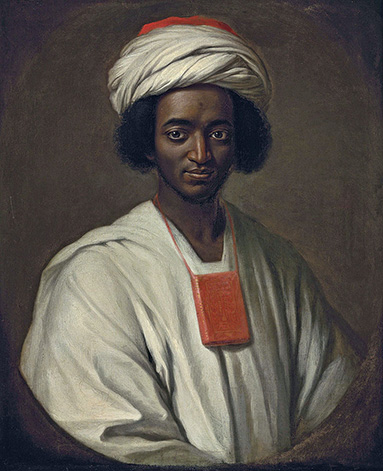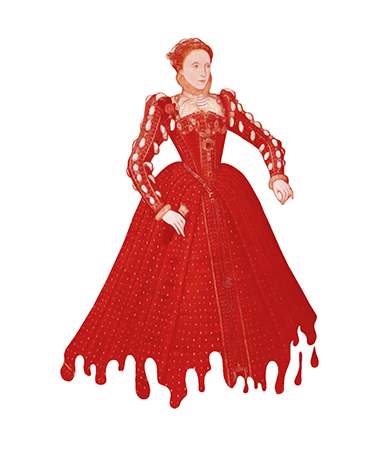Queen Elizabeth I went global by pioneering the slave trade
It’s winter and I’m on the top deck of a bus in London, heading from Brixton, South London, to central London. Through Westminster, across Pall Mall, and past all the monuments, which crystallize a fabled time when Britain reclined easily in its place in the world. The friend I’m meeting texts to say he’s running late, so when I land in Trafalgar Square I pass through the National Portrait Gallery’s revolving doors into its dark entryway.
I’ve come for the portrait of Ayuba Suleiman Diallo, a West African man who was enslaved in 1731 but managed to find his way home again. Diallo is Britain’s favorite type of migrant. He enriched Britain with his free labor, astounded some white people with his book learning, and then fucked off back to Africa where he came from.
For a while, William Hoare of Bath’s portrait Ayuba Suleiman Diallo, Called Job Ben Solomon (1773) didn’t seem to belong anywhere. In 2009, a private collector sold the painting at Christie’s to the Qatar Museums Authority (QMA). But when QMA attempted to export the painting in 2010, the British government barred its export and offered any interested British museum the opportunity to buy it. The Portrait Gallery’s acquisition campaign raised more than £400,000, arguing that the image is “the earliest known British oil portrait of a freed slave and the first portrait to honor an African subject as an individual and an equal.” But in the end QMA refused the gallery’s offer, and now there’s a notice beside the portrait: “Property of Qatar.”

Slavery is not something Britain likes to talk about, that is unless we’re talking about modern-day slavery (perpetrated by black or brown people) or about our role in dismantling the Atlantic trade. A crude sketch of what the British learn about slavery at school: a deplorable condition that ended long ago thanks to Thomas Clarkson and William Wilberforce, and which took place in the Americas—in the renegade colonies—elsewhere. So why this attachment to a portrait of a handsomely dressed West African man wearing a beatific smile and a turban?
At the National Portrait Gallery, the wall behind Diallo has been painted mauve to mark it out as a special exhibition. Two blocks of non-narrative text surround the portrait. On the left is a word cloud, which appears to be the result of a primary school brainstorming session. The nouns “stories,” “seas,” “silence,” “empires,” “language,” “life,” “riddle,” and “chains” hover in indeterminate abstraction, with “freedom” at their pinnacle. To the right is a poem by Ben Okri, and then the portrait description:
Ayuba Suleiman Diallo was an educated man from a family of Muslim clerics in West Africa. In 1731 he was taken into slavery and sent to work on a plantation in America. Recognised as a deeply pious and educated man, in England Diallo mixed with high and intellectual society, was introduced at court and was brought out of slavery by public subscription.
Framed in this way, Diallo’s image tells a story palatable to British audiences unwilling to reckon with the enormous displacement, disenfranchisement and dehumanization wrought by the Atlantic slave trade. In this version, even at the height of slavery an African could hoist himself up by the bootstraps, and find his reward in the embrace of British intellectual society. While Americans were wallowing in the moral filth of plantation slavery, the British stood ready to bestow freedom on exceptional Negroes who washed up on these civilized shores.
A timeline at the gallery offers additional context. Britain’s first slaving expeditions took place under Queen Elizabeth I (1533–1603). The timeline moves quickly on to the abolitionists, but it’s fun to sit a while with Elizabeth whose started-from-the-bottom-now-we’re-worldwide story was captured in the 1998 film starring Cate Blanchett, a film which glosses over the fact that Elizabeth I went global by pioneering the slave trade.
Facts that do not appear on the National Portrait Gallery Timeline: While he was still alive, Elizabeth’s father Henry VIII bought a 700-ton ship called The Jesus of Lubeck, which Elizabeth inherited. By 1564 she’d heard about the success of early slaving expeditions and decided to lend the ship Jesus to a man called John Hawkins who sailed to West Africa where he “got into his possession partly by sworde and partly by other meanes to the number of 300 negroes.” In Sierra Leone he managed a further 500. That Elizabeth I had so much to do with the sight of a ship named Jesus bearing down on West African shores is a fact that should be better known. In 1568, the Queen presented John Hawkins with a coat of arms. The design pictured an enslaved African person, to reflect the trade in humans Hawkins had pioneered.
Dates that do not appear on the National Portrait Gallery Timeline: 1596. Elizabeth issues an order to expel all the black people in Britain, writing to the Lord Mayor of London “there are of late divers blackmoores brought into this realme, of which kinde of people there are allready here too manie.” It was her “good pleasure to have those kinde of people sent out of the lande.” Her reasons are familiar:
i. to protect the purity of English blood
ii. to protect the livelihood of British servants who might “perishe for want of service” given the availability of cheap black labor
1601. Because it wasn’t clear enough the first time, Elizabeth complains again about the “great numbers of Negars and Blackamoors which are crept into this realm” and “who are fostered and relieved here to the great annoyance of her own liege people that want the relief which those people consume.” She insists that “the said kind of people should be with all speed avoided and discharged out of this Her Majesty’s dominions.”
In the gallery, a white woman swaddled in a dark winter coat turns to face Diallo. She glances up at the word cloud, carefully reads the description and then angles herself to read Okri’s poem. Her concentration lapses and when she feels my eyes on her, she scuttles away towards the permanent collections. Maybe like me she’s irritated by these abstractions that tell us little about Diallo. Perhaps she wants to know: Did he stoop to say his prayers in the tobacco fields of the Maryland plantation where the British slavers shipped him? Did he meet other West Africans in London? If so, how did he greet them? When he boarded the ship to Gambia, was he afraid that beneath the jubilation of his homecoming there would be shame too? Can the British ever truly reckon with this history if it is always held apart and discussed always in relation to black bodies and not in relation to whites? I imagine a word cloud surrounding Elizabeth I’s coronation portrait: “Pioneer of chattel slavery” and “early proponent of British border enforcement” and wonder if, in fact, it is my presence the woman cannot face.
My phone buzzes and I make my way to meet my friend in the gallery shop. On my way I pass a portrait I would spend hours staring at as a child, on summer holiday visits to Central London. The subject is a young woman with opaque white skin and hair worn in copper ringlets. She has the kind of hair that really knows how to hold a curl. I think about the brazen memory of black hair, which, however it is pulled and pinned, knows how to revert, how to return. Her smile pinches her lips so firmly that each corner of her mouth is a full stop. I remember my English teacher’s thumbs pressed firmly into the corners of my desk as she insists that the Dark Lady of Shakespeare’s sonnets is not dark in that sense. What was I looking for when I searched these white faces for a “touch of tar?” The truest face of British history, its blackness elliptical and submerged?
All the tea towels and mugs and postcards in the Gallery shop have been colonized by prints of Marilyn Monroe and Diana Princess of Wales, apart from an exclusive collection of leather objects bearing Queen Elizabeth I’s coronation portrait. I’ve already decided on a handful of pencils and when my friend joins me I’m fingering a wallet from that collection. I’ve been thinking about reparations since the Mau Mau case, and since 15 Caribbean nations (CARICOM) announced their intention to sue the British government. After Benedict Cumberbatch’s mother encouraged him to go in fear of descendants of slaves who might lay claim to his family’s fortune, I looked up my mother’s maiden name on a database which catalogs the reparations paid by the British government to British slave owners who “lost property” when the trade was abolished. A man called Herbert Newton Jarrett V was awarded £13,591 in compensation for the 695 people he enslaved in the Orange Valley Estate in Trelawny, Jamaica. As it turns out, my mother’s maiden name carries this other meaning. It also turns out Herbert attended the same college I did. It seems right, then, that Elizabeth’s face should sit in my hand. She would not have anticipated my using her face as an object to stuff money into.
Six months later I pull out my wallet in a health shop in Brighton Beach, Brooklyn, and the Russian-American girl behind the counter asks, “Is that a Queen Elizabeth I wallet? I’m so jealous!” I ask her why she’s such a fan of Elizabeth and she says, “I mean, 45 years of peace and prosperity! Who can argue with that?” In the moment, faced with her elation, it feels utterly futile to insist on the human cost of 40 years of peace and prosperity, to say, as I usually would, “On whose back?”, to insist on my presence in that old narrative. I pay for my tincture and go.
